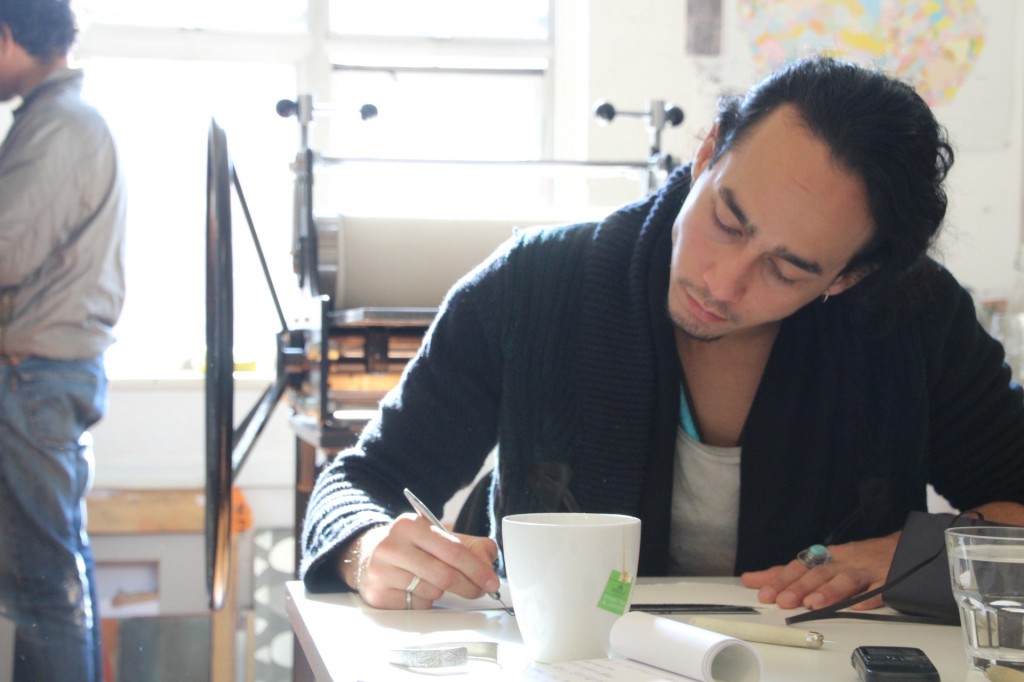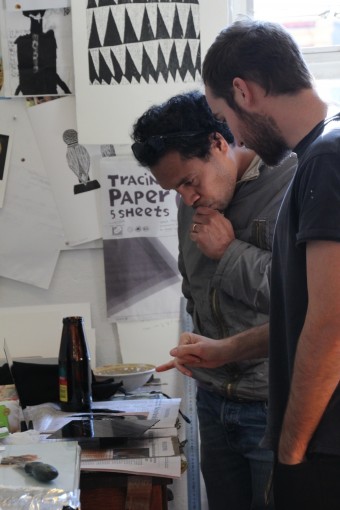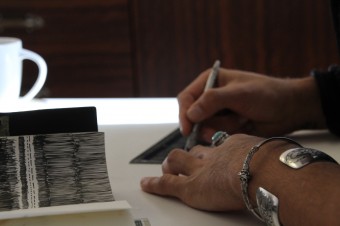
The sunlight drifts through the loft studio, Artur Brotolaras keeps his eyes focused on his hands. Holding the metal pen he scratches fine, calculated downward strokes on to the etching plate. He doesn’t look up to talk to me.
“So I’ve got these memories when I was five years old, of my old house it used to be made of bamboo. It just keeps on coming into my head, it’s always there. One of them is the walls of my house, they are all bamboo woven, it’s always in my mind. I used to remember seeing the sun coming through, making rays of light. So I finally put that into the etch.
“When I saw this I was really attracted to making more stuff, this one
is the rough alang-alang, satin tail in English, it was used for strengthen the soil for rice paddies, back in Bali, but I’ve made it more of a pattern now.”
The space is called The Ownership Project and it is a not-for-profit art-gallery and studio working space in Fitzroy set up in 2011 to help culturally diverse people to find a voice through print-making. Leuli Eshraghi, who works for the organisation, tells me they have worked with Aboriginal, Torres Strait Islander, South Americans and East-African migrants before but the current project is their first time supporting Pacific Islanders.
Their aim is to support those voices not regularly heard in the art community, providing opportunities for people to gain experiences through printmaking and express themselves.
“Print making is a very expensive and long process so we provide the space and the equipment for those who want to use it. We support artists who need support, helping them get stuff exhibited, getting grants and then we also have projects like this one which help encourage non-artists who want to make a start.”
Sean Smith, who started the studio, modelled it off the many Indigenous art centres he worked with in Arhnem Land. “Melbourne does have a lot of good opportunities for artists, there is a lot of support and opportunities for great visibility that there just isn’t in Sydney or Brisbane,” he said.
“However the problem is producing art to the high-standard required. However we have had quite a few artists who have come through here, used the facilities and the support and have gone on to do some really fantastic stuff so that’s always great.”
The studio now receives funding grants from City of Yarra and others and it has enabled them to keep the space running. However the studio is small and they are hoping to able to expand to enable them to work with more than a couple of artists at a time.
Chico Dos Santos is an East-Timorese man working with Sean, he is doing art for the first time.

“When I first came to do this thing, I had no idea what I would do. I told Sean I’m not sure how far I will go. He helped me develop what I had as an initial idea and I’m putting it together now. After this project I’ll definitely be keen to do more art in the future.
Chico tells me a story of how he was just a child when the Dili massacre of 1991 that killed over 200 people happened. “It was all right near my house. My dad nearly died, he was running around trying to collect all us kids from school, he nearly got shot when he was running through all the shooting.”
He shows me his work, the etching consists of two parts; the first is an etching of the traditional Timorese Tai fabric woven pattern. The second is a tree supported by a closing fissure, he explains it to me.
“I came up with drawing these sharp lines to show the conflict, and then I closed the lines to get rid of the sharpness till it moves towards a solid rock, that can support the tree. So it’s about unity but it starts by showing the sharpness, the fight, before it closes. So basically it’s trying to tell the story of Timor.”
————————————————————
The Ownership Project upcoming events can be found here


